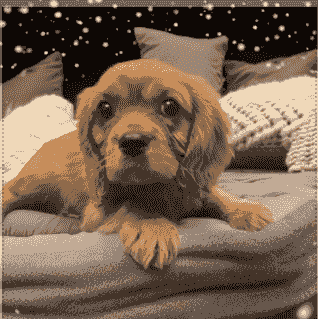



Moon Dream Cavaliers
- Our Program
- Puppies
- …
- Our Program
- Puppies



Moon Dream Cavaliers
- Our Program
- Puppies
- …
- Our Program
- Puppies

What to know when you adopt a new puppy

Separation Anxiety
What Is Separation Anxiety in Dogs?
Separation anxiety is a behavioral condition in which a dog experiences intense distress when left alone or separated from their guardian. While many dogs may bark occasionally or seem unhappy when their people leave, dogs with true separation anxiety display more severe and often destructive behaviors that go beyond simple boredom or a need for training.
Common signs of separation anxiety may include:
- Excessive barking or howling shortly after being left alone
- Destructive behavior such as chewing, digging, or scratching—especially around doors and windows
- Urinating or defecating indoors, despite being house trained
- Pacing, drooling, or other physical signs of anxiety
- Attempts to escape, which can result in injury
It’s important to understand that not every dog who shows one or more of these behaviors necessarily has separation anxiety. Many of these signs can also stem from other causes, such as a lack of mental stimulation, poor house manners, or even a change in routine. It's perfectly normal—and emotionally healthy—for a dog to miss their human when they’re gone.
Dogs are social animals, and their bond with their people is often very strong. Also, dogs do not perceive time the same way humans do. So, when dogs act overjoyed to see their guardian after a short absence, it doesn’t necessarily mean they were suffering in distress—it could simply reflect their excitement at the reunion.
Separation anxiety isn’t a sign of disobedience or bad behavior—it’s a true emotional response rooted in fear and attachment. Understanding what is and what isn’t separation anxiety is the first step in helping your dog feel more secure and happy while you're away.
What Causes Separation Anxiety in Dogs?
There’s no single cause of separation anxiety in dogs, and researchers haven’t yet identified exactly why some dogs develop it while others do not. However, patterns have emerged that suggest certain experiences and environmental factors may increase a dog’s risk. One of the strongest indicators is a history of change or loss.
Dogs who have been surrendered to shelters, rehomed, or passed between multiple guardians are significantly more likely to develop separation anxiety than dogs who have remained with one person or family since puppyhood. The loss of a previous caregiver—or even a more subtle change in the household, like a family member moving out—can leave a dog feeling insecure and anxious about being left alone again.
Some life changes that may contribute to separation anxiety include:
- Being surrendered to an animal shelter or rescue
- Changes in the household routine, such as a new work schedule
- Moving to a new home
- Loss of another pet in the household
- Change in the family structure (e.g., divorce, child going to college)
While these events can increase the likelihood of separation anxiety, it’s important to understand that how a dog is raised and supported also plays a role. Good socialization starting early in life—ideally beginning with a responsible breeder or rescue and continuing in the new home—can help prevent fear-based behaviors. Teaching a puppy or newly adopted dog how to feel safe when left alone is a valuable life skill.
Steps to help reduce the likelihood that a dog will develop separation anxiety:
• Crate training
• confidence-building exercises
• gradual desensitization to being alone
• structured routines
These proactive steps can also help dogs with mild anxiety from worsening, especially during life transitions. Ultimately, every dog is an individual. Some may be more genetically predisposed to anxiety, while others may react to environmental stressors more intensely. The good news is that with the right support, most dogs can learn to feel safer and more secure when left alone.

How to Treat and Manage Separation Anxiety in Dogs
Helping a dog with separation anxiety takes time, consistency, and patience. The good news is that most dogs can improve with the right approach. Treatment strategies depend on the severity of the anxiety and the individual dog’s needs. Below are methods for managing and reducing separation anxiety, from mild to more complex cases.
Mild Separation Anxiety signs:
- Pacing
- Whining
- Following their guardian closely before departure
Prevention and confidence-building strategies:
- Desensitize departures: Pick up your keys, put on your shoes, or grab your bag—then don’t leave. Repeat often. This helps your dog stop associating these cues with being left alone.
- Short, low-key departures and returns: Avoid dramatic goodbyes or overly enthusiastic reunions. Keeping comings and goings calm can reduce emotional spikes.
- Offer enrichment during alone time: Use puzzle toys, KONGs stuffed with high-value treats, or slow feeders to keep your dog busy and help them associate alone time with good things.
- Exercise first: A tired dog is less likely to become anxious. A walk or play session before you leave can set the stage for rest.
Moderate Separation Anxiety signs:
- Barking
- Destructive chewing near exit points
- House soiling shortly after their guardian leaves
Prevention and confidence-building strategies:
- Gradual desensitization to alone time: Start by leaving your dog alone for just a few minutes and gradually increase the duration. This requires many short, successful sessions over time.
- Create a “safe zone”: Some dogs do best with a designated calm area—like a crate (if properly crate-trained), a playpen, or a quiet room with familiar items.
- Counter-conditioning: Help your dog form new emotional associations to being alone. For example, always give a special high-reward treat or chew only when you leave—and take it away once you return.
- Consistency in routine: Dogs thrive on predictability. A structured daily routine can help lower overall stress and reduce anxiety around departures.
Severe Separation Anxiety signs:
- Panic as soon as they realize their guardian is leaving
- Destructive behavior such as destroying doors or windows
- trying to escape,
- nonstop barking and/or excessive drooling
Prevention and confidence-building strategies:
- Work with a professional: A certified dog trainer or veterinary behaviorist can tailor a desensitization program specific to your dog’s needs. Severe cases require slow, methodical progress with expert guidance.
- Avoid long absences when your puppy/dog is first introduced into your home
- Arrange for pet sitters, doggy daycare, or a trusted friend or family member to help care for your dog while you work on treatment.
- Consider medication: For some dogs, short- or long-term anxiety medications (prescribed by a vet)
Our Program
Puppy Culture Method
This comprehensive socialization and training program provides support from birth until the puppies are ready to go home. Operating on a foundation of positive reinforcement, we closely monitor each puppy's development and introduce suitable challenges to foster their confidence and equip them with the necessary skills for a successful future.
Health & Behavior
Our primary objective is to enhance the overall health of the Cavalier King Charles Spaniels through selective breeding. Although this breed may be predisposed to a few health issues such as certain eye conditions, patella luxation, hip dysplasia, middle ear infections, mitral valve heart disease, and syringomyelia, it is crucial to acknowledge that these conditions can be effectively identified through screening processes. By providing appropriate care and attention, Cavaliers can enjoy a comfortable life well into their senior years.
In our breeding program, we diligently conduct DNA testing for all our female dogs and carefully pair them with studs that possess compatible DNA profiles, ensuring a positive genetic advancement. Furthermore, we adhere to the highest standards by extensively employing OFA testing and certifications, exclusively utilizing studs that have received their own OFA certification.
When acquiring a Cavalier puppy, we strongly urge potential owners to select a responsible breeder who places significant importance on health-testing all potential breeding stock. This conscientious approach not only contributes to the overall well-being of the breed but also significantly elevates the likelihood of acquiring a robust and thriving companion.
Some History
In 1926, Roswell Eldridge placed an ad challenging British breeders to bring back a royal breed of spaniels that were on the edge of extinction. He sought to recreate the old type of Blenheim Spaniels shown in pictures of Charles II’s time. After Charles II's death in 1685, the appearance of his spaniels began to change due to a fascination with flat-faced breeds from Asia. Eldridge offered a cash prize for male and female spaniels that matched his description, and despite initial disinterest, several dogs entered Eldridge's special classes at a famous dog show. Gradually, breeders started intentionally breeding the restored spaniel, and a club was formed for this new breed. The breed, known as Cavalier King Charles Spaniels, was officially recognized by the British Kennel Club in 1945 and by the AKC in 1996. Eldridge's motivation for restoring this breed is unknown, but his efforts were successful in bringing back a spaniel breed that had mostly existed in paintings. Although Eldridge didn't live to see it, these spaniels are still around today.
Family Stories
We adopted Bailey at 9 weeks, our 2nd time adopting (our first Cavi is now 10 mos) with Moon Dream. Both had a headstart on crate and potty training, and both were exposed to kids and pets. More importantly both were very loved, and came to us as confident pups with many experiences already such as car rides and spa grooming. We received many pupdates while they grew and matured. Could not ask for any more from a loving and responsible breeder. Would not hesitate to adopt from Katie! ❤️Leanne
LeeLoo came to us highly socialized. I'm a convert now to the training that Katie does with all the puppies at Moon Dream Cavaliers. Katie sent us pictures and updates throughout the process. She loves her dogs and is the most responsible breeder I've ever worked with . Would highly recommend this breeder.
Diana
This is a long overdue review, but we just knew we had to leave one. From the very first time we communicated with Moon Dream Cavaliers to take home day and everything in between, was nothing short of professional and caring. Katie is not only extremely knowledgeable of the breed but she truly cares for each of her puppies. She also cares about the families who will be adopting. She answered all of our questions promptly and was up front and honest every step of the way. We were able to meet the Mom of our puppy prior to the birth. Katie kept us informed with calls, texts, and photos daily. Katie also went above and beyond and did some specialized training and socialization with our puppy before we took him home. She also worked on potty training. This made the transition to our home easy. He was well behaved and responded to our training and prompts very well, and continues to be a mild mannered well behaved puppy. Our family just loves him. We cannot say enough positive things about our overall experience with Katie and Moon Dream Cavaliers.
Jessica
Proudly built with Strikingly.

